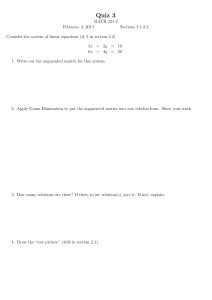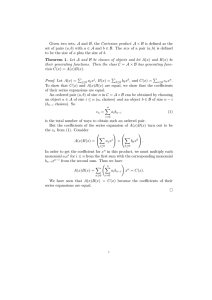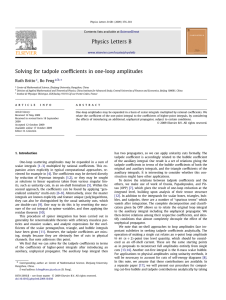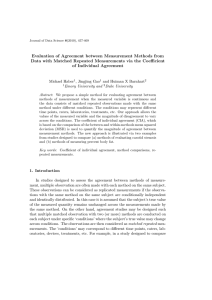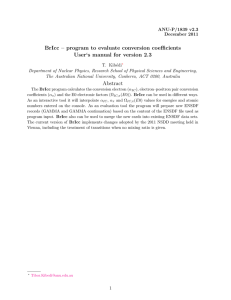Take Home FINAL EXAM Fall Term 2003 Plasma Transport Theory
advertisement
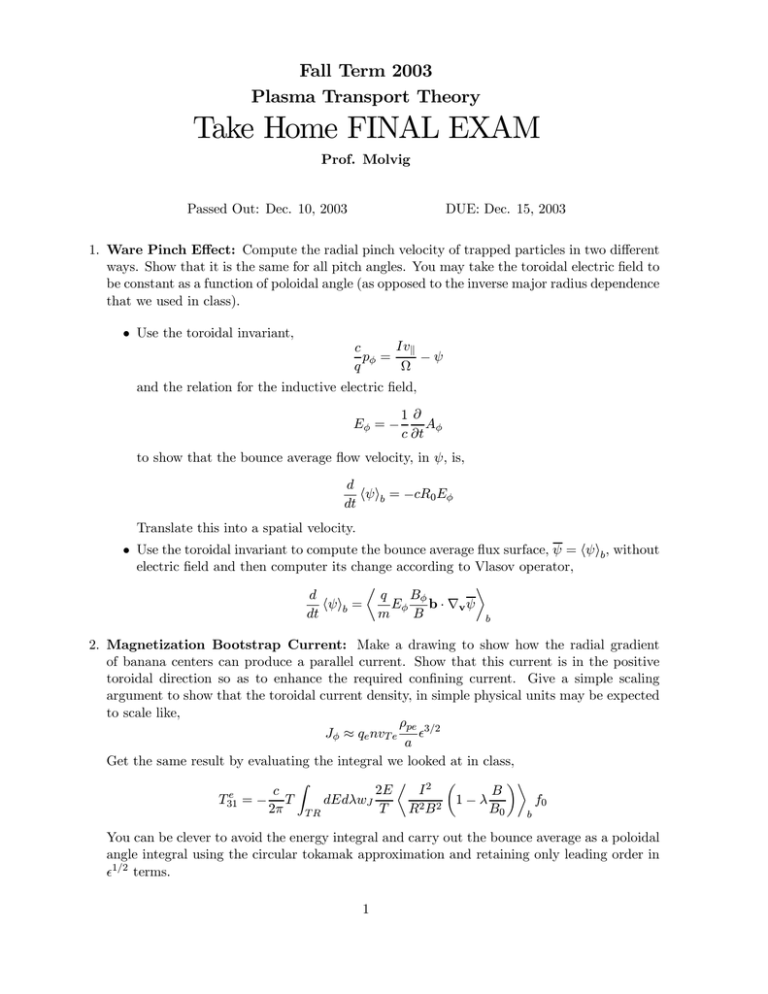
Fall Term 2003 Plasma Transport Theory Take Home FINAL EXAM Prof. Molvig Passed Out: Dec. 10, 2003 DUE: Dec. 15, 2003 1. Ware Pinch Effect: Compute the radial pinch velocity of trapped particles in two different ways. Show that it is the same for all pitch angles. You may take the toroidal electric field to be constant as a function of poloidal angle (as opposed to the inverse major radius dependence that we used in class). • Use the toroidal invariant, Ivk c pφ = −ψ q Ω and the relation for the inductive electric field, Eφ = − 1∂ Aφ c ∂t to show that the bounce average flow velocity, in ψ, is, d hψib = −cR0 Eφ dt Translate this into a spatial velocity. • Use the toroidal invariant to compute the bounce average flux surface, ψ = hψib , without electric field and then computer its change according to Vlasov operator, ¿ À Bφ d q hψib = Eφ b · ∇v ψ dt m B b 2. Magnetization Bootstrap Current: Make a drawing to show how the radial gradient of banana centers can produce a parallel current. Show that this current is in the positive toroidal direction so as to enhance the required confining current. Give a simple scaling argument to show that the toroidal current density, in simple physical units may be expected to scale like, ρpe 3/2 ² Jφ ≈ qe nvT e a Get the same result by evaluating the integral we looked at in class, ¿ 2 µ ¶À Z I 2E B c e 1−λ dEdλwJ f0 T31 = − T 2π T R2 B 2 B0 TR b You can be clever to avoid the energy integral and carry out the bounce average as a poloidal angle integral using the circular tokamak approximation and retaining only leading order in ²1/2 terms. 1 3. Simplified Implicit Transport Coefficient: The implicit transport coefficient for the pinch effect (a collisional process involving circulating particles) can be written, XZ ∂ i dEdλf0 Dλψ g3 T13 =− ∂λ σ where, ∂g3 /∂λ, can be written, ∂ σewJ λ g3 = − q ∂λ Dλλ τ b where, q, is the geometric safety factor. The generalized Fokker-Planck coefficients, Dλλ , Dλψ , can be written, ¿ µ ¶À B B Dλλ = 4ν ei (v) λ wJ 1−λ B0 B0 b À ¿ I mcI 0 ∂ω b V Dλλ + σν ei (v) 2λ vk Dλψ = σ 2πe ∂λ Ω J Show that the transport coefficient can be written, 3 i c i nψ = T I13 T13 4 2π i , can be expressed, where the dimensionless integral, I13 à ! Z 1−² 1 ∂ω b i H I13 + = 4π dλλ B ∂λ 2 dθ 0 u B0 (1 − λB/B0 ) where the dimensionless velocity, u, and “bounce” frequency, ωb , are given as, p u ≡ 1 − λB/B0 I dθ ωb ≡ u i ∼ ²1/2 , and calculate an actual number. Now evaluate the integrals to show that I13 Hint: µ ¶ 2² π E ' 1+²−λ 2 Where E is the complete elliptic integral of the second kind. If this hint is really too obscure you may talk to Yong. . . 4. Diagonal Transport Coefficients: Prove that the implicit diagonal transport coefficients, Tiii = − (αi , gi ), are positive definite, by actually carrying out the integration by parts to write integral with positive definite integrand. 5. Onsager Symmetry of Transport Coefficients: Express the implicit off-diagonal transport coefficients, Tiji = − (αi , gj ), in a form that is manifestly symmetric by writing out the integral in terms of the kinetic cross coefficient, Dλψ , appearing in the first order collision operator, ∂ ∂ ∂ ∂ Dψλ f0 + Dλψ f0 C1 = ∂ψ ∂λ ∂λ ∂ψ New helpful comment: You need to show that the coefficient used to compute flux from first order distribution function is the same coefficient used to compute the first order distribution itself (by inverting zero order collision operator). 2

